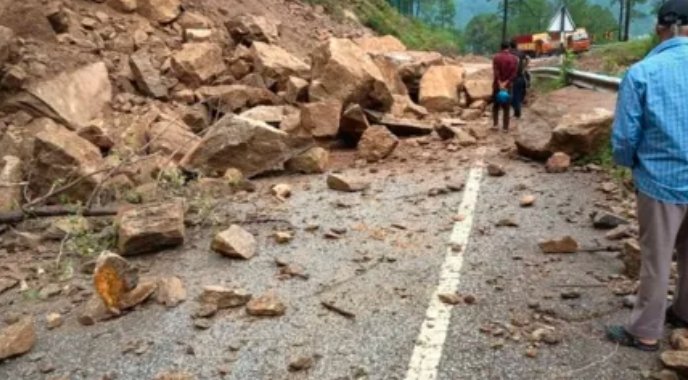The A83 road in Argyll, Scotland, has reopened after heavy rain triggered 11 landslides that blocked the route near the Rest and Be Thankful area. The closure started early Monday morning, forcing drivers onto a long detour, but cleanup crews finished their work by Tuesday morning, allowing traffic to flow again.
Heavy Rain Sparks Multiple Landslides
Torrential rain hit the Argyll region hard in the early hours of September 1, with about 76 millimeters falling in just five hours around Butterbridge and Glen Kinglas. This intense downpour caused slopes to give way, leading to 11 recorded landslides along a short stretch of the A83.
Two of these slides dumped mud and debris directly onto the road, blocking it in both directions between Ardgartan and the A815 Dunoon junction. A third slide was stopped by a roadside barrier, but the damage was enough to shut down the main route.
Bear Scotland, the group in charge of road maintenance, quickly assessed the situation. They found that the Old Military Road, often used as a backup during such events, was also blocked by debris. This left no quick alternative, pushing traffic onto a 59-mile diversion through A819, A85, and A82.
Local communities felt the impact right away, with some areas cut off and emergency services on high alert. Past events in this spot show a pattern, as the steep hillsides here have long been prone to slips during wet weather.

Cleanup Efforts and Road Reopening
Teams from Bear Scotland worked around the clock to clear the mess. They removed tons of mud, rocks, and water from the road and nearby ditches, while engineers checked the hillsides for any ongoing risks.
By 9:30 a.m. on September 2, the A83 was back open after final safety checks. Traffic lights remain in place at key spots like Rest and Be Thankful and Glen Kinglas to manage flow and watch for issues.
Euan Scott, a spokesperson for Bear Scotland, praised the hard work of the crews. He noted that monitoring would continue over the coming days, especially with more rain possible in the forecast.
This quick response highlights improvements in how these incidents are handled, drawing from lessons learned in recent years. For instance, similar landslides in 2023 led to multi-day closures, but better barriers and faster teams have cut downtime.
The following table shows key details from this event compared to a past one:
| Aspect | September 2025 Event | October 2023 Event |
|---|---|---|
| Number of Landslides | 11 | Multiple (exact not specified) |
| Rainfall Amount | 76 mm in 5 hours | Heavy over days |
| Closure Duration | About 24 hours | Several days |
| Detour Length | 59 miles | Similar routes |
Impact on Drivers and Local Areas
The sudden closure created headaches for thousands of drivers, many heading to work or traveling through the scenic Argyll and Bute region. The detour added hours to journeys, raising fuel costs and frustration levels.
Businesses in nearby towns like Inveraray and Lochgoilhead reported slower traffic, affecting tourism and deliveries. One local resident shared that emergency supplies had to be rerouted, delaying help for isolated spots.
Safety was a big concern too. With debris flowing onto roads, there was a real risk of accidents if the slides had happened during peak hours. Thankfully, no injuries were reported this time.
Here are some tips for drivers in landslide-prone areas:
- Check weather apps before trips to spot heavy rain risks.
- Follow official updates from Traffic Scotland for real-time road status.
- Pack extra water and snacks in case of unexpected delays.
- Use apps like Waze for alternate routes during closures.
History of Landslides in the Region
The Rest and Be Thankful section of the A83 has a long track record of landslides, often tied to Scotland’s wet climate and steep terrain. Records show dozens of incidents over the past decade, prompting calls for long-term fixes.
In 2020, a major slide led to talks about building tunnels or better barriers. Recent investments have added bunds and catchment areas to trap debris, which helped contain some slides this week.
Experts point to factors like sheep grazing on hillsides, which can loosen soil, and climate change bringing more extreme rain. A 2012 report linked grazing to increased slip risks, and while some steps have been taken, the problem persists.
Communities have pushed for a permanent solution, such as a new route or upgraded defenses. Government plans are in the works, but progress has been slow, leaving locals worried about future events.
Looking Ahead to Prevent Future Closures
With climate patterns shifting, more heavy rain events could hit Argyll. Officials are exploring options like improved drainage and vegetation to stabilize slopes.
Transport Scotland has shared artist impressions of potential tunnels, which could bypass the risky areas. These ideas aim to make the A83 more reliable for the long haul.
For now, the focus is on recovery and vigilance. Drivers are urged to stay informed and plan ahead.
What do you think about these repeated landslides? Share your thoughts in the comments below, and pass this article along to anyone planning a trip through Argyll.


















